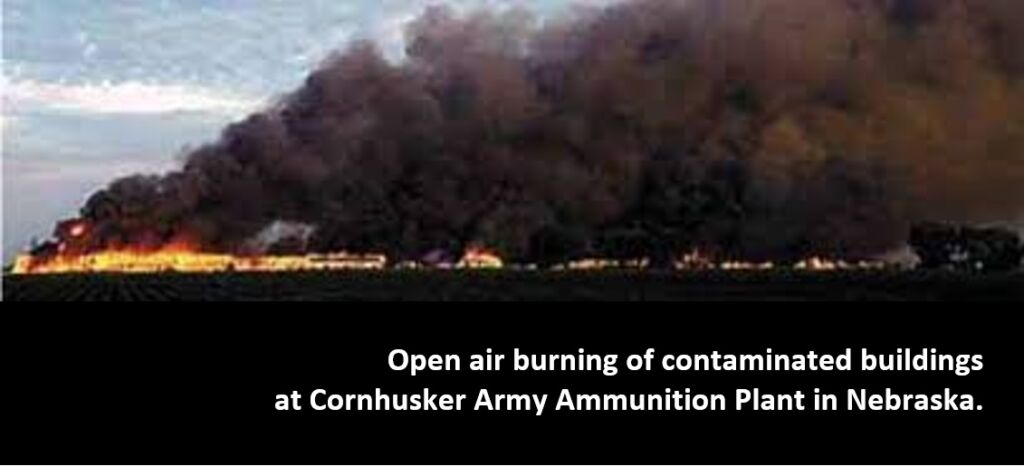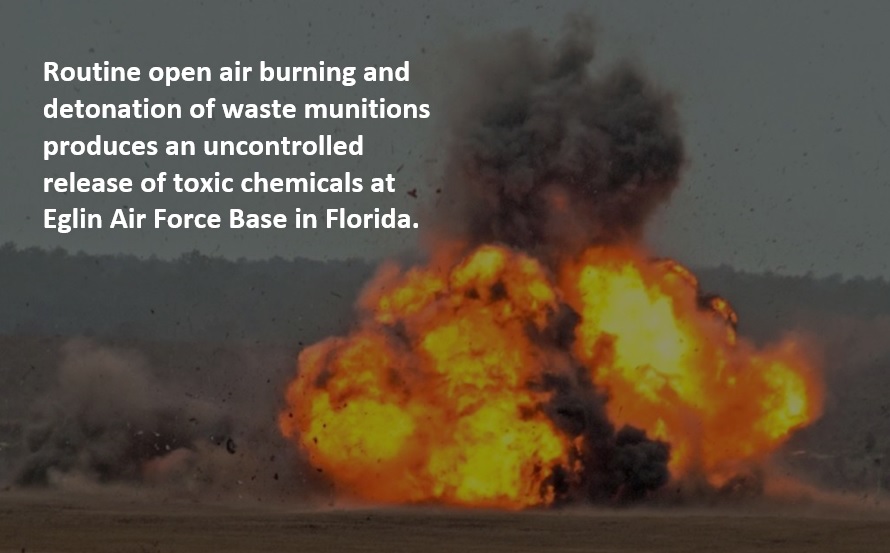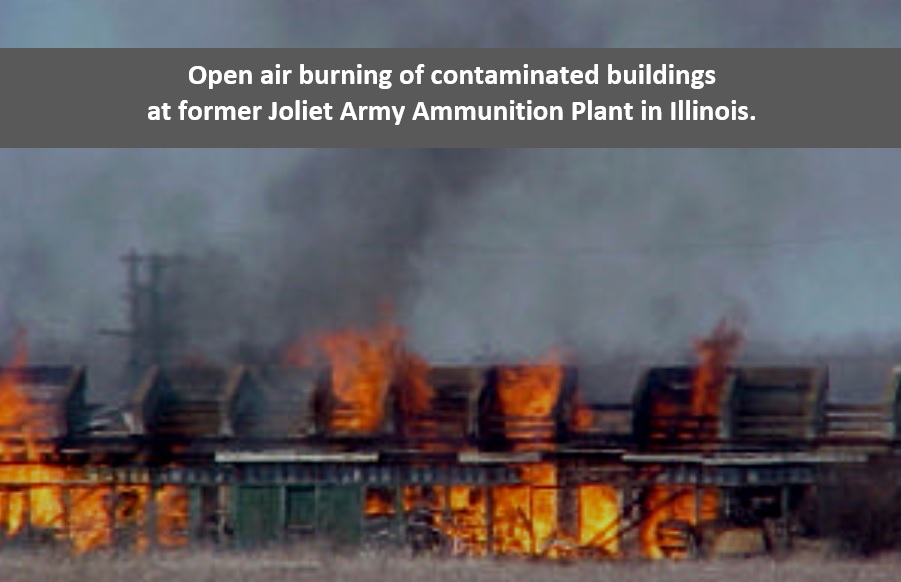
Photograph: EPA continues to permit Indiana’s Crane Naval Surface Warfare Center to open air burn and detonate as much as 109 million pounds of hazardous energetic waste every YEAR. Despite the availability of advanced alternative technologies, open burning units like this one at Crane produce a chronic uncontrolled release of dioxins, toxic metals, PFAS, perchlorates, depleted uranium and other toxic emissions to the environment — placing the health of base workers, onsite contractors, communities, and service members and their families at risk.
NATIONAL — Officials with EPA’s waste office say the agency needs “more time” to craft strict new rules for open burning/open detonation (OB/OD) hazardous waste incineration to identify and evaluate alternative technologies, intensifying environmentalists’ threats to sue the agency to force a ban on the practice and claim proven alternatives are already available.
If the agency does not issue a regulation soon, Earthjustice intends to follow through on its recent 60-day notice threatening to sue the agency to enforce its “ongoing obligation” to issue the rule by a date certain, Thien Chau, an attorney with the group said.
His comments come after several EPA regional officials told attendees at an Oct. 27 session of the Association of State and Territorial Solid Waste Management Officials’ (ASTSWMO) annual conference in Arlington, VA, that a ban on OB/OD would likely “take more time,” despite repeated calls from environmental groups to quickly enact a rule.

One of the officials said that evaluating safer alternative technologies to OB/OD, and any rule limiting the practice, “will not happen overnight.” The speaker added that it “will take time to . . . fund, permit, and construct alternatives.”
The official added that EPA’s Office of Resource Conservation and Recovery (ORCR) “is focusing on addressing concerns regarding open burning and open detonation of waste explosives,” especially after the release of two reports in 2019, by EPA and the National Academy of Sciences, Engineering, and Medicine (NASEM), that documented several alternative technologies for treating waste explosives.
“Specifically, ORCR is developing a proposed rulemaking to revise the regulations with respect to OB/OD in consideration of the availability of safe alternative treatment technologies. This rule is currently in interagency review. EPA expects to publish the proposed rule later this year,” reads a handout for the session.
“ORCR is working with regions and states, and regulated facilities, including [the Defense Department (DOD)] to address implementation of existing requirements, while also continuing to move forward on the updated rulemaking,” it continues.
But environmentalists are already threatening suit to force a quick rulemaking. In August, Earthjustice, representing six state- and local-level citizen groups, sent a notice of intent (NOI) charging that the agency has ignored a “nondiscretionary duty” under the Resource Conservation and Recovery Act (RCRA) to strengthen its decades-old rules governing disposal of military munitions and other waste explosives.
And the next month, more than two dozen environmental groups signed a letter asking Senate appropriators to launch an audit of natural resource damages stemming from the Defense Department’s (DOD) use of OB/OD.
While EPA in 1980 banned open burning of hazardous waste under RCRA, it provided an exception for its use on waste explosives, which it said could not be safely disposed of through other means. But facing community concern, EPA is crafting a proposed rule that would narrow the exemption after the 2019 reports from the agency and NASEM.
EPA’s waste office late last year outlined a preliminary draft of the upcoming rule, with plans to specifically bar OB/OD of energetic wastes containing certain per- and polyfluoroalkyl substances (PFAS) and other substances.

Despite ongoing opposition from community advocates, EPA signaled at that time that it is continuing plans to allow exceptions for use of OB/OD of some hazardous waste explosives.
‘Overdue Obligation’
In May, EPA sent for White House review a proposal that is expected to limit the use of OB/OD at the 66 facilities that currently use it while increasing use of alternative disposal technologies. However, it has yet to be approved for formal publication, and the agency’s approach is unlikely to satisfy environmentalists, who have long sought a ban.
But the lengthy rulemaking process EPA officials described at the ASTSWMO conference may now deepen that conflict.
“EPA has had a long overdue obligation to review and revise the regulation, and although it’s acknowledged the need to revise the regulation . . . this isn’t the first time EPA says it’s [going to] have to push the date back,” Earthjustice attorney Chau said.
And Laura Olah, who signed the Senate letter on behalf of Wisconsin-based Citizens for Safe Water Around Badger (CSWAB), said that she is “discouraged” and “very concerned about further delays” following the officials’ remarks, arguing in particular that there has already been extensive study of substitutes for OB/OD.
“EPA should have been pushing hard for alternatives,” she says, adding that it has instead allowed an “interim period” where it is still issuing permits for the military to continue OB/OD even while crafting potential restrictions.
“These permits last for ten years. And the technologies are available now,” she says.

She adds that DOD has argued that OB/OD is cheaper than alternative technologies, but says that claim ignores the heavy costs of cleanup. She pointed to the Badger Army Ammunition Plant where groundwater remediation has cost about $250 million. “[T]he groundwater extraction system cost [about] a million dollars a year just to operate, and we still have explosive contamination in groundwater that’s unsafe and [puts] people [at] risk,” she says.
“Further delay is just impossible to live with, because safer alternative technologies have been around for decades,” Olah says. “It’s only going to move forward if we ban it.”
She also noted that OB/OD has been linked to per- and polyfluoroalkyl substances (PFAS) contamination, since when incineration does not destroy the chemicals, they “just get[] thrown up into the air and settled on surface water, which accumulates in fish and people.”
PFAS “[don’t] even respond to hazardous waste incineration, and it’s highly mobile. It certainly doesn’t burn in an open fire, all it does is disperse it,” she says.
by Sarah Mattalian, Inside Washington Publishers, November 3, 2023. Photographs and associated text added by CSWAB.
-END-
Notice of Intent to Sue EPA Nondiscretionary Duty RCRA EarthJustice 31 Aug 2023
Request Congressional Audit of Resource Damage OB OD Patty Murray FINAL 20 Sept 2023
Draft Revisions OB OD EPA Presentation Slides 2022
